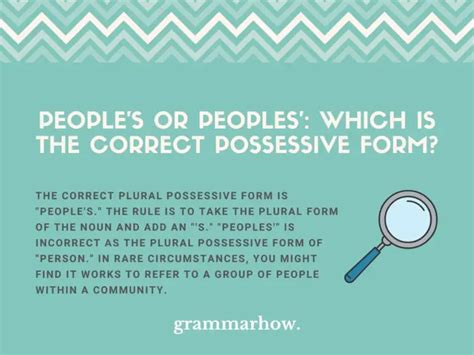The distinction between “people’s” and “peoples” is a subtle yet crucial aspect of grammar that often poses challenges for many. Understanding the correct usage of these terms is essential for effective communication and to convey intended meanings accurately. In this comprehensive guide, we will delve into the definitions, usage, and grammatical rules surrounding “people’s” and “peoples,” ensuring clarity and precision in your writing and speech.
People’s: The Possessive Form
“people’s” is the possessive form of “people,” indicating that something belongs to or is associated with people in general. It is used to express possession or relationship, similar to how apostrophes are used with other nouns (e.g., cat’s toy). The use of “people’s” reflects a singular concept of people as a whole entity.
Examples:
- The people’s choice for the award was surprising.
- The people’s voices were heard through the democratic process.
- The museum is a people’s palace, open to everyone.
Peoples: The Plural Form
On the other hand, “peoples” is the plural form of “people,” referring to multiple groups of people, each considered as a distinct entity. This term is used when discussing different nations, ethnic groups, or any collection of people where each group maintains its individuality.
Examples:
- The United Nations represents peoples from almost every country in the world.
- The indigenous peoples of the Americas have rich and diverse cultures.
- The festival celebrated the music and dance of various peoples from around the globe.
Key Differences and Usage
The primary difference between “people’s” and “peoples” lies in their grammatical function and the concepts they represent. “People’s” signifies possession or a characteristic of people as a single, unified group, while “peoples” refers to multiple, distinct groups of people.
- Possession vs. Plurality: If you’re describing something that belongs to people in general, use “people’s.” However, if you’re talking about multiple distinct groups, “peoples” is the correct choice.
- Singular vs. Plural Concept: “People’s” treats people as a singular concept, whereas “peoples” acknowledges the diversity and individuality of different groups.
Grammatical Rules and Exceptions
While the distinction between “people’s” and “peoples” might seem straightforward, there are nuances and exceptions, particularly in legal, historical, and cultural contexts.
- Legal and Historical Documents: In some legal and historical texts, “peoples” might be used to refer to the population of a specific region or country, emphasizing the diversity within.
- Cultural Sensitivity: When discussing indigenous or ethnic groups, it’s essential to use the term they prefer. Some groups might identify as a singular “people,” while others see themselves as part of a broader collection of “peoples.”
Conclusion
In conclusion, mastering the correct grammar between “people’s” and “peoples” is not just about following rules; it’s about understanding the nuances of language and the concepts these terms represent. By recognizing when to use the possessive “people’s” and when to refer to multiple groups as “peoples,” you can enhance the clarity, respect, and precision of your communication.
What is the main difference between "people's" and "peoples"?
+The main difference lies in their grammatical function: "people's" is possessive, indicating something belongs to people, while "peoples" is plural, referring to multiple distinct groups of people.
How do I decide when to use "people's" versus "peoples"?
+Use "people's" when describing something that belongs to or characterizes people as a whole. Use "peoples" when referring to multiple, distinct groups of people, emphasizing their individuality and diversity.
Yes, there are exceptions, particularly in legal, historical, and cultural contexts. It's also important to be sensitive to the preferred terminology of indigenous or ethnic groups when referring to them.
By applying these guidelines and understanding the context in which “people’s” and “peoples” are used, you can ensure that your communication is not only grammatically correct but also respectful and effective. Remember, language is a tool for expression and connection, and its nuances can significantly impact how our messages are received and understood.



